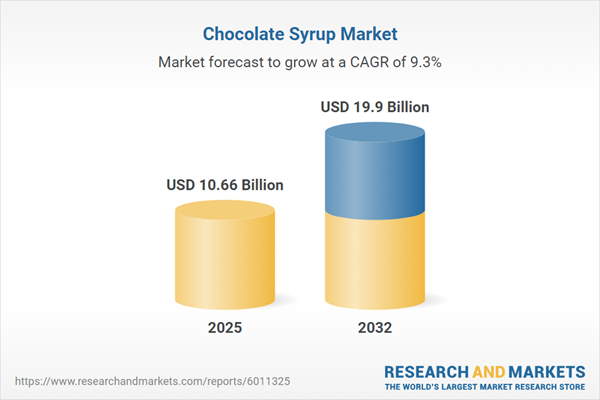Speak directly to the analyst to clarify any post sales queries you may have.
The chocolate syrup market is evolving rapidly, shaped by shifting consumer appetites, innovation in processing, and broader industry trends. As brands respond to heightened demand for indulgence, premium experiences, and transparency, manufacturers and investors face a dynamic environment rich in opportunity and competitive complexity.
Market Snapshot: Chocolate Syrup Market Growth Outlook
The chocolate syrup market grew from USD 9.77 billion in 2024 to USD 10.66 billion in 2025. Moving forward, the category is projected to further expand at a CAGR of 9.29%, reaching USD 19.90 billion by 2032. Strong demand drivers include the ongoing rise of specialty beverages, evolving consumer tastes, and retail innovation across global markets.
Scope & Segmentation
The report analyzes the chocolate syrup sector in depth, examining end-user preferences, distribution models, and packaging innovations that define the competitive landscape. Key segmentation includes:
- End Users: Foodservice operations (hotels, catering, restaurants, cafes) and household consumers.
- Distribution Channels: Convenience stores, online retail (ecommerce marketplaces, grocery portals, manufacturer websites), supermarkets, and hypermarkets.
- Packaging Size: Under 250G, 250 to 500G, over 500G.
- Packaging Type: Glass bottles, plastic bottles, sachets, tubes.
- Product Type: Dark chocolate, milk chocolate, white chocolate variants.
- Regions Covered: Americas (including U.S., Canada, Mexico, Brazil, Argentina, Chile, Colombia, Peru), Europe, Middle East & Africa (U.K., Germany, France, Russia, Italy, Spain, Netherlands, Sweden, Poland, Switzerland, UAE, Saudi Arabia, Qatar, Turkey, Israel, South Africa, Nigeria, Egypt, Kenya), and Asia-Pacific (China, India, Japan, Australia, South Korea, Indonesia, Thailand, Malaysia, Singapore, Taiwan).
- Key Companies Analyzed: The Hershey Company, Nestlé S.A., Dr. Oetker GmbH, Monin SAS, Torani, Inc., Ghirardelli Chocolate Company, The J.M. Smucker Company, International Flavors & Fragrances Inc., Symrise AG, 1883 Maison Routin SAS.
Key Takeaways for Decision-Makers
- Innovation in clean-label, organic, and flavor-infused chocolate syrups is expanding addressable opportunities in both foodservice and grocery segments.
- Digital transformation is rapidly changing consumer touchpoints, with omnichannel retail and e-commerce subscriptions increasing brand visibility and loyalty.
- Sustainability pressures are prompting manufacturers to adopt recyclable packaging and transparent sourcing strategies that support both environmental goals and market access.
- Regional dynamics demand localized product adaptations, from premium gourmet offerings in Western Europe to price-focused and versatile formats in Africa and Latin America.
- Collaboration between producers, ingredient specialists, and foodservice operators is accelerating new product development and expanding chocolate syrup applications beyond traditional dessert uses.
Tariff Impact: Navigating Regulatory Change
The most recent United States tariff measures on imported cocoa derivatives and finished chocolate syrups introduce new complexity for sourcing and cost structure. Importers are responding by adjusting procurement channels and exploring trade program participation. Domestic processors are renegotiating supplier agreements and optimally restructuring production runs to defend margin stability. Formulation adjustments, like using alternative or locally sourced ingredients, are also under consideration to manage input volatility and secure competitive pricing.
Methodology & Data Sources
This report incorporates a hybrid approach, drawing on qualitative interviews with industry experts and structured consumer surveys, coupled with extensive secondary analysis of trade publications and regulatory data. Findings are validated using a peer-reviewed process and triangulation with manufacturer disclosures and supply chain databases, ensuring recommendations are rigorous and actionable.
Why This Report Matters
- Empowers strategic planning with detailed segment and regional analyses to inform go-to-market and investment decisions.
- Highlights practical strategies for mitigating regulatory risks and capitalizing on sustainable and digital trends within the chocolate syrup ecosystem.
Conclusion
The chocolate syrup market is poised for further transformation, driven by the convergence of innovation, sustainability, and shifting consumer behaviors. Success will be defined by agility in adaptation and a commitment to operational excellence and strategic insight.
Additional Product Information:
- Purchase of this report includes 1 year online access with quarterly updates.
- This report can be updated on request. Please contact our Customer Experience team using the Ask a Question widget on our website.
Table of Contents
3. Executive Summary
4. Market Overview
7. Cumulative Impact of Artificial Intelligence 2025
Companies Mentioned
The companies profiled in this Chocolate Syrup market report include:- The Hershey Company
- Nestlé S.A.
- Dr. Oetker GmbH
- Monin SAS
- Torani, Inc.
- The Ghirardelli Chocolate Company, LLC
- The J.M. Smucker Company
- International Flavors & Fragrances Inc.
- Symrise AG
- 1883 Maison Routin SAS
Table Information
| Report Attribute | Details |
|---|---|
| No. of Pages | 198 |
| Published | October 2025 |
| Forecast Period | 2025 - 2032 |
| Estimated Market Value ( USD | $ 10.66 Billion |
| Forecasted Market Value ( USD | $ 19.9 Billion |
| Compound Annual Growth Rate | 9.2% |
| Regions Covered | Global |
| No. of Companies Mentioned | 11 |









